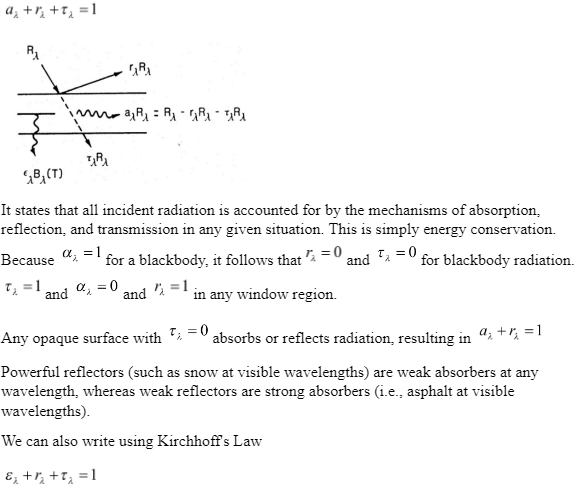Every point on a plane surface emits radiation in all directions into the hemisphere above the surface. Intensity is used to express various radiation fluxes such as emissive power, irradiation, and radiosity.
Emissivity, absorptivity, reflectivity, and transmissivity of materials, as well as their connections with wavelength, direction, and temperature, are discussed. The greenhouse effect is used to illustrate the ramifications of radiation characteristics being wavelength-dependent.
Absorption and Emission:
When the body is radiating and absorbing in thermodynamic equilibrium, the dimensionless coefficient of absorption (or absorptivity) is the fraction of incident light (power) that is absorbed by the body.
The emission of an arbitrary opaque body of defined size and shape at a specific temperature can be characterized by a dimensionless ratio, sometimes called emissivity.

Kirchhoff’s law asserts, in simplified terms, using this definition: The emissivity is equal to the absorptivity for any arbitrary body emitting and absorbing heat radiation in thermodynamic equilibrium.
ε(T)=∝(T)
Conservation of Energy
To understand the concept of conservation of energy we will consider an absorbent medium layer in which only a part of the total incident radiation Iλ is absorbed, and the rest is either transmitted through or reflected from it. To put it another way aλ, rλ, tλ indicate fractional absorptance, reflectance, and transmittance, respectively, then the absorbed part of the radiation must equal the total radiation minus losses. Hence,

According to this, all incident radiation for media in thermodynamic equilibrium is accounted for by emission, reflection, and transmission.
Reflection
The reflectivity is bi-directional in nature, which sets it apart from the other qualities. That is, the value of a surface’s reflectivity is determined by both the direction of incident radiation and the direction of reflection.
There are two types of reflection.
- When the angle of incidence equals the angle of reflection, it is called specular reflection.

2. Diffuse reflection occurs when a reflected incident beam is scattered uniformly in all directions.

Emissivity
Emissivity is the ratio of the radiation released by a surface at a certain temperature to the radiation emitted by a blackbody at the same temperature. The ability of an object to emit infrared energy is measured by its emissivity.

The value of is in the range of 0 to 1, and it indicates how closely a surface resembles a blackbody.
Absorptivity
Absorptivity is another important radiation parameter of a surface which is the percentage of incident radiation energy absorbed by the surface. Its value, like emissivity, is between 0 and 1.

Real objects cannot absorb all incident light because their absorptivity is less than unity. Some of the incident light may be passed through the body, while others may be reflected at the body’s surface, resulting in partial absorption. The absorbed and reflected portions of the intensity of radiation incident at a specific wavelength in a specific direction are characterized as spectral directional absorptivity and spectral directional reflectivity of a surface, respectively.
Reflectivity

When the sample reflects volumetrically including its interior if it is semi-transparent to thermal radiation, the term “reflectivity” is sometimes understood as the ratio of the mentioned fluxes. In this scenario, the reflection is dependent on the sample thickness, hence we advocate using the word “reflection coefficient” instead of “reflectivity.” Reflectivity computation and measuring procedures are extensively developed.
The reflection is specular and the angle of reflection is equal to the angle of incidence for an optically smooth sample surface. If the refractive index and absorption index of the sample material is known, Fresnel’s formulas can be used to compute the value of reflectivity as a function of incidence angle.
Radiation Absorption and Emission in the Atmosphere
A considerable part of solar energy (approximately 50%) passes through the atmosphere and is absorbed by the earth’s surface in a clean environment free of clouds and aerosols. The energy emitted by the planet is absorbed mostly by carbon dioxide, water vapour, and ozone in the atmosphere. The atmospheric effect is the trapping of heat infrared radiation by atmospheric gases, which is typical of the atmosphere.
Conclusion
Thus, Absorption, Reflection, and Emission are three key terms used while describing the process that happens after radiation strikes a surface and a black body. The ability of an object to emit infrared radiation is assessed by its emissivity, which is measured by reflection. Their coefficients with the formulas are also explained which will be used to solve numerical problems.
 Profile
Profile Settings
Settings Refer your friends
Refer your friends Sign out
Sign out













